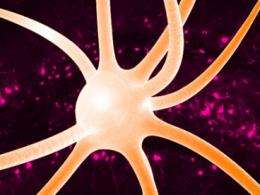Researchers find that interneurons are not all created equally

(PhysOrg.com) -- A type of neuron that, when malfunctioning, has been tied to epilepsy, autism and schizophrenia is much more complex than previously thought, researchers at MIT's Picower Institute for Learning and Memory report in the Sept. 9 issue of Neuron.
The majority of brain cells are called excitatory because they ramp up the action of target cells. In contrast, inhibitory cells called interneurons put the brakes on unbridled activity to maintain order and control. Epileptic seizures, as well as symptoms of autism and schizophrenia, have been tied to dysfunctional inhibitory cells.
"Too much activity and you run the risk of uncontrolled activity, while too little leads to cognitive and behavioral deficits," said Mriganka Sur, Paul E. Newton Professor of Neuroscience, whose laboratory carried out the study. "Normal brain development and function hinges on the delicate balance between excitation and inhibition."
For a long time, interneurons, which make up only one-fifth of brain cells, were thought to be a kind of generic, homogenous shutdown agent. The MIT study points to a new view: At least some interneurons have very precise responses and form specific connections and circuits.
"If these cells are targeted in brain disorders, then these disorders must arise from precise dysfunction in specific circuits," said Sur, head of the MIT Department of Brain and Cognitive Sciences. "This study sheds light on precisely what is going on in these circuits that may be targeted for future treatments."
Inhibitory cells are diverse: researchers are only starting to discern distinct electrophysiological profiles, shapes and molecular signatures among the 20 or more known types.
But all interneurons fall into two clear subtypes: those that target the cell body, or soma, of their target cells and those that target the branchlike dendrites. The soma-targeting type expresses a protein called parvalbumin and has been linked to brain disorders and circuit development. This type of interneuron was thought to dampen activity uniformly across the cortex. "Our paper overturns this view," Sur said.
"These neurons had been thought to have only broad response features that would nonspecifically dampen their target cells. Our finding indicates that they have well-defined properties and functions," he said.
MIT graduate student Caroline Runyan and postdoctoral fellows James Schummers, Audra Van Wart and Nathan Wilson used cutting-edge techniques to examine the properties of parvalbumin-expressing inhibitory neurons.
With the help of mice genetically engineered to have just these cells fluoresce red in their visual cortex, the researchers used a sophisticated technique called two-photon imaging to identify and record the activity of these cells in living animals.
They found that parvalbumin-expressing interneurons have a range of response features. Many of these cells have precisely tuned responses. Some only respond to very specific signals and locations in space.
"These cells are components of and contributors to highly specific networks that shape the selectivity of neuronal responses," Runyan said. "They need to be defined by a combination of features, including structure, connections, gene expression profiles, electrophysiological properties and response types.
"This study supports the idea that individual cell classes may provide specific forms of inhibition and serve unique functions," she said.
More information: "Response features of parvalbumin-expressing interneurons suggest precise roles for subtypes of inhibition in visual cortex" by TK TK. Neuron, 9 Sept. 2010.














